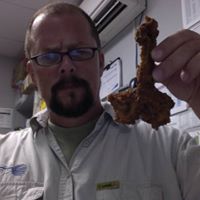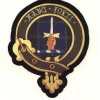Leaderboard
Popular Content
Showing content with the highest reputation on 08/15/2011 in all areas
-
I didn't see any rib fx immediately on the shoulder xray, but pulmonary contusion could be a huge factor for this guy... the arm was clearly forced into the ribs and that could have been enough to cause a pulmonary contusion...cardiac also....maybe. Also from the amount of facial trauma seen on the first photo, I would be for sure interested in what a facial series looked like as well as a face/brain CT. Since he claims to have been seat-belted at the time, any signs of a lap belt injury? Would have really liked to see pictures of this accident to have an idea of the forces involved, but from the one xray you showed, must have been a good amount of force. Side note...we once had a mid-shaft femur fracture come into us, and he was sitting up and talking completely fine.... Dropped a flat-screen tv on his thigh and snapped it in two. No other trauma occurred. Made me realize that not everything that you would think is a huge trauma, there can be freak isolated injuries that we would normally associate with more complex issues.2 points
-
Yeah, we weren't trying to bust your balls. Just some overall opinions and concerns. Quite frankly, if you can't interpret a 12-lead, there isn't much point in adding this to your scope unless of course you have the ability to transmit to the hospital. Acquiring a 12-lead is easy, reading it and correctly interpreting it are quite another. Good luck with your class and keep the questions coming. There is no such thing as a stupid question here and this site is an excellent resource for you. There are some really smart and experienced providers on here.2 points
-
Wow, same here, never thought of this before, nor do i recall reading anything on it. Perhaps the point is that they dont have to exhibit a marked change in vital signs, but that they become symptomatic? If patient become symptomatic due to lack of parasympathetic response leading to symptoms even though they still have technically "normal" vital signs they are still symptomatic and hence have reduced cerebral perfusion?2 points
-
The title of the thread was Cali steady burn: By the time he plugs all that whacker crap into his cigarette lighter ,the nissan will be a steady burn pile2 points
-
The second picture is probably the best way to sling a dislocated shoulder. That is what I know as the neutral position for the shoulder or the position of use. How often do we have our forearms lay flat against our bellies versus having our arms out a little and to the side? Even as I type this there is a little space in my armpit and my forearms are facing forward. Think about how when a shoulder dislocates what happens. The humeral head in most cases will roll anteriorly and drop inferiorly a little bit. (I'm guessing your friend had an anterior dislocation so I won't go into inferior or posterior dislocations unless you want me to.) When you try to move the forearm across the abdomen and it is still dislocated, you are putting a tremendous amount of stress and pressure on that humeral head. By abducting (moving the humerus away from the body) the shoulder by about 15 degrees, you are relieving that pressure and more often than not easing the patients pain and reducing the muscle spasms. After shoulder surgeries, depending on the type, you will see more and more often now people being placed in what is called an Ultra Sling which has that padding and holds the arm at a more natural position. All in all when it comes to splinting, it's hard to do the wrong thing medically if your patient is more comfortable. ETA: more info.1 point
-
Unless your company is buying their own cheap razors, all of the razors I've seen with the defib equipment, even if they looked ordinary were pretty aggressive. You certainly can rip the hair off, and it may be the better way, but it's guaranteed to generate complaints from that patients family...'specially if it's their mom you're working on... :-) Dwayne1 point
-
The part about the steady burning red light is true, has been since the 60's. That was about the only accurate to real life part of the ambulance Mother drove in Mother, Jugs & Speed. Courtesy lights. I have one, LED, it has 82 flash patterns. I have it set to flash on.. and flash off.. slowly. I only use it if I'm parked on the road, that way I don't get struck. I neither want to die, nor become a finger puppet for a trauma team.1 point
-
DFIB ... as you wish. Mass and Temperature (remaining constant) the volume of a gas is directly proportional. That stated: with the pressure decreases there is also shift of the ODC, (the oxygen dissociation curve) which in this case presentation, So if the curve shifts with a decrease .. what happens to the affinity of the haemoglobin for oxygen ? Hence my question for pressurised vs non pressurized, you can be in a typical helo at just 5000 ft agl but in fixed wing you can have a cabin pressure of 3000 ft agl and actually be at 25,000 ft agl and "over the weather in calm air" ... now look back at the patient picture, is the musculoskeletal injury life threatening or is something else you may wish to make note in clinical observation ???? must have been one hell of a high impact to bust buddy's arm this bad, any other concerns for going flying ? Ah Bushy, just wake up mate ? Agreed. Im tired of seeing people jam 15 L/min on everybody, even when they know the patient isn't aneamic! Twisted ankle = 02, paper cut = 02, boggles the mind (and the 02 cylinder rental costs im told ) I am not a fan of the toxic effects of O2 ... te he, (a high potential for ARDS) but my reasoning was, with the rather liberal amounts of analgesia that I was using to control pain, was that oximetry changes could indicate a hypoventilation state (late).. but was relying on ETCO2 as primary tool for hypoventilation, for a near conscious sedation. I really did not want to push Narcan or have to ETI on board but with the "yet to be identified" life threatening issue, sorry no AP CXR available. (hint with the good clinical observation skills applied) and no pneumo but we are getting closer close (ps) vascular lines to periphery was the hint that no pneumo present initially although that can change when Boyle puts his physics to work , a small closed pneumo becomes a lot bigger with increase in altitude. Probably myoglobin, i dont know the normal values though. That is one .. myglobinuria better, any others ? Its "poikilothermia" a failure to thermoregulate. Ah the presenter becomes the student .. you sheep shagger ! Ill see if i can find it, but there was retrospective analysis done here on tension pneumo's that were missed in the field, led to an education pack coming out where they got us to be more aggressive in identifying and manageing, there was a good stretch in it about trending ETCo2 and the missed pneumo. Ah send it to me svp, that svp is french btw and good thing you don't have to deal with those spy talkers like we do. Let me get back to you boke, i dont understand ETCo2 or fully remember treatment for hyperkalaemia due to my lazyness (i used to). I went to some joint once and learned some stuff then got a job and forgot most of the stuff that i learn't I wasn't concerned about hi K+, could give ventolin while on board, but not going the glucagon and insulin because we don't carry insulin and this was a stable no CP distress, no big ass T waves and K excelate was out definatly of the question, but we are getting a bit off topic direction. rhabdo treatment was where I was headed ... any ideas ? hint TVI flight time was 1.5 hours, then add 40 mins for ground transport both ends. I was curious about the 30 to 32 ETCO2 although .. I think I can explain it but one can not be 100% why he was hyperventilating just a tad any comments ? cheers1 point
-
Again I'm afraid I don't have a hard number. In one patient I might feel that the pulse goes from full at 72 to slightly thready at 90 and take that as a positive sign. Another might be full at 72 yet bounding at 82 and I consider that significant. Actually, I wanted to lie really bad on this because I'm kind of embarrassed to admit that I've never really taken orthos very seriously. It's like the GCS, it seems everyone does it but me, and has really good reasons for it, but I just fail to see them. I too am excited to see where this thread is going. Dwayne1 point
-
I think we are missing the the crucial point. She was a nitro taker that had already taken one with no effect. Radiating crushing chest pain. Doesn't sound like pectoral angina. I would have requested ALS intercept as soon as I suspected an MI. High priority transport. Load and go. ASA was a good call. If MC recomended nitro that is his business I think i would have questioned his call on a direct line and recuested confirmation after he had a chance to review the case again. I agree with scratrat and jake EMTP. I would begen assisted ventilations and prepare the airway adjuncts, AED, and suction as a precaution.1 point
-
LOL Richard... or maybe Kelly Grayson .. he is known to have a few knee slappers "his own self' that (self acclaimed coon ass Louisiana good ole boy. ER doc I woulds say an increase of 10 % in pulse rate and changes of 20/10 ... time would be more of a consern if pulse did not return to base line (say 5 minutes) .. i know this is controversial. Personally a one beer infusion makes me dizzy when standing up too quickly, that when I realize its empty and need another, its sounds like a good justification to me re: "orthostatic hypotension" so I am going with that, as an answer for door number one.1 point
-
I think you did fine, caught everything. One thing Iv gotten into the habit of with any chest pain is a BP on both arms.1 point
-
Did you verify that B/P yourself, and did you trend it during transport? Any change? I'm with Ruff, within the parameters that you've allowed for this question, there is nothing else significant that you could have done. A 'just in case' IV wouldn't have been out of the question in my opinion, but I doubt I would have done so on this patient. I'm guessing that this time things are more or less what they appear to be, some minor gastric distress. Of course that ASA/transport was spot on. Good job, though I'm curious why you've chosen to keep this within the Basic SOP? Ahhh...wait, you downgraded this call and let your basic partner attend, didn't you? And now someone is trying to jam you up for allowing a BLS provider to attend to an 'ALS' patient? . If so...I'm not opposed to that decision, depending on the partner. Dwayne1 point
-
1 point









